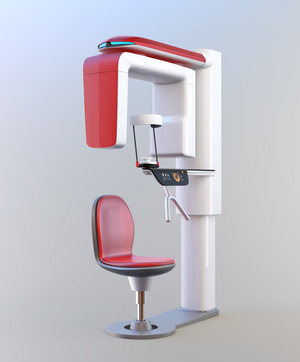
One of the most important aspects of dental implant placement is precision. The implant posts have to be inserted at exactly the right spots in your mouth in a way that lets them join with the bone while also avoiding nerves and other dental structures. Your dentist will need to gather as much information as possible about your jaw to ensure that your implants are placed correctly – and to do that, they need to use an advanced piece of dental technology known as a cone beam scanner.
What Exactly is a Cone Beam Scanner?
A cone beam scanner is used to create a comprehensive model of your mouth. The device moves around your head, using a cone-shaped X-ray beam to take pictures of your teeth, your jawbone, and other oral structures. Using these pictures, the scanner can create a single three-dimensional image, which can be viewed at different angles as needed.
Dentists use cone beam scanners for procedures where a traditional X-ray wouldn’t be enough to capture all the necessary information. The model that the scanner creates makes it possible to determine the location of nerve paths, evaluate bone density, and check for other crucial details that could affect the success of the treatment.
Why is a Cone Beam Scanner Needed for Placing Dental Implants?
The high level of detail that cone beam scanners are able to capture has led to them being considered an indispensable part of the dental implant process. For one thing, the technology makes it easier to determine which parts of the jawbone have enough bone density to support dental implant posts. This helps the dentist determine where the dental implants need to go and at what angles.
A cone beam scanner can also be used to identify potential obstacles for dental implant placement. For example, sometimes there might be some nerve pathways near the intended implant site. And if you need implants for your upper arch, your sinuses could get in the way if they’re too close to your jaw. These structures need to be accounted for during the planning process to ensure that placing implants won’t damage them.
What are the Benefits of Using a Cone Beam Scanner to Place Dental Implants?
Some of the advantages that come with having dental implants placed with the help of a cone beam scanner include:
- A higher chance of success thanks to the implants being placed in exactly the right spot.
- A quicker, smoother placement process.
- The confidence that comes with knowing that your implant surgery is being performed as precisely as possible.
Have you been thinking of getting dental implants? Take the time to confirm that the dentist you’ve chosen for the procedure utilizes a cone beam scanner; after all, your smile deserves the best treatment that modern dental care can offer.
About the Author
Dr. Shahram Modarres has been bringing his patients personalized dental care for more than 20 years. He graduated from the New York University School of Dentistry, and he is currently a member of the American Academy of Implant Dentistry. At Rockville Family Dentistry, he’s able to place dental implants in-house with the aid of a state-of-the-art cone-beam scanner. To schedule an implant consultation with Dr. Modarres, visit his website or call (301) 816-9400.

